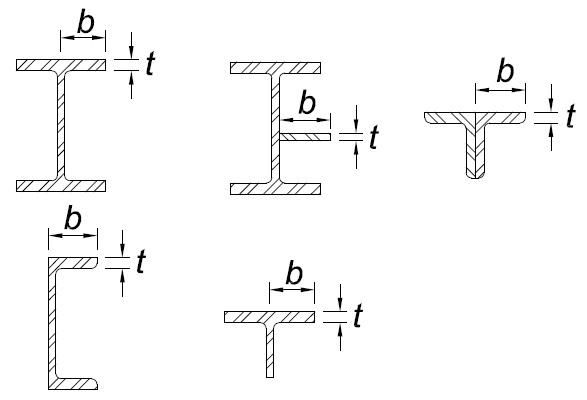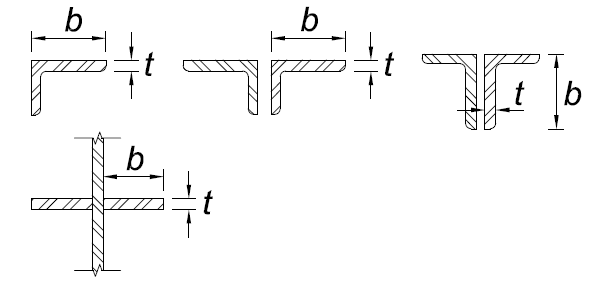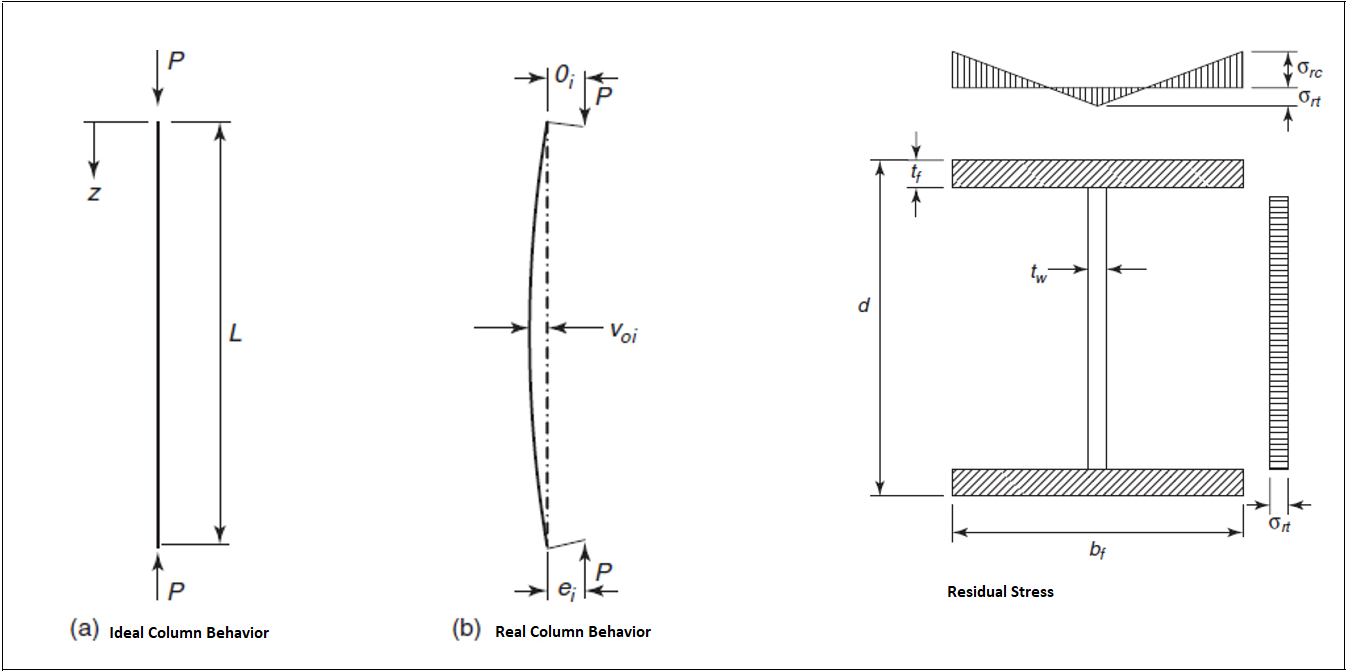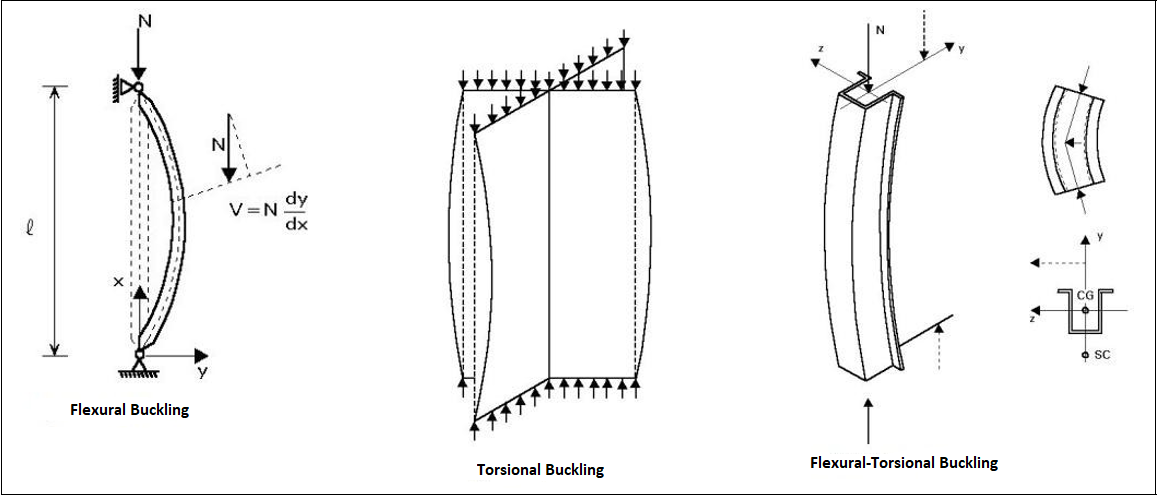Design of Steel Members for Compression per AISC 360-16 §E
How does ideCAD calculate steel members' compression strength according to AISC 360-16?
The compression strength of steel elements is calculated automatically according to AISC 360-16.
The nominal compressive strength limit states of flexural buckling, torsional buckling, and flexural-torsional buckling are controlled automatically according to AISC 360-16.
Symbols
Fy = Specified minimum yield stress
E = Modulus of elasticity of steel = 29,000 ksi (200 000 MPa)
Pn : Nominal compressive strength, kips (N)
λr = Limiting width-to-thickness parameter for noncompact element
λp = Limiting width-to-thickness parameter for compact element
Compression Strength of the Steel Elements
Compression steel members are structural elements subjected only to axial compressive forces; the loads are applied along a longitudinal axis through the centroid of the member cross-section.
Since some eccentricity of the load is inevitable, the ideal state cannot be reached, and therefore, a bending situation called buckling occurs.
There are two main types of buckling, local and global buckling, for elements subjected to axial compression force.
Local Buckling
Local buckling occurs when some part or parts of the cross-section of a column are so slender that they buckle locally in compression. However, the strength corresponding to any buckling mode cannot be developed if the element of the cross-section is so thin that local buckling occurs.
The measure of this susceptibility is the width-thickness ratio of each cross-sectional element.
Limit values for the classification of cross-sections for the local buckling boundary condition are given in AISC 360-16 B.4 and Table B4.1a for cross-sections under compressive force.
The design compressive strength =
The allowable compressive strength =
TABLE B4.1a | ||||
|---|---|---|---|---|
Case | Element Description | Width-to-Thickness Ratio | Limiting Width-to-Thickness Ratio λr (nonslender/slender) | Examples |
1 | Flanges of rolled I-shaped sections, plates projecting from rolled I-shaped sections, outstanding legs of pairs of angles connected with continuous contact, flanges of channels, and flanges of tees | b/t |
|  |
2 | Flanges of built-up I-shaped sections and plates or angle legs projecting from built-up I-shaped sections | b/t |
|  |
3 | Legs of single angles, legs of double angles with separators, and all other unstiffened elements | b/t |
|  |
4 | Stems of tees | d/t |
|  |
5 | Webs of doubly symmetric rolled and built-up I-shaped sections and channels. | h/tw |
|  |
6 | Walls of rectangular HSS | b/t |
|  |
7 | Flange cover plates and diaphragm plates between lines of fasteners or welds | b/t |
|  |
8 | All other stiffened elements | b/t |
|  |
9 | Round HSS | D/t |
|  |
*Cases 1, 2, 3, and 4 are Unstiffened Elements. Cases 5, 6, 7, 8, and 9 are Stiffened Elements. | ||||
Global Buckling
Elements under the effect of compression may not function as an ideal compression element for various reasons, although the flexure moment does not occur due to loads. The most important reasons are:
Initial Curvature
Load eccentricity
Residual Stresses

Global buckling is divided into three categories: Flexural buckling, Torsional buckling, and Flexural-Torsional buckling. These types of buckling are also the limit states of members under compression.

Flexural Buckling Limit State
The buckling deformations all lie in one of the principal planes of the column cross-section. No twisting of the cross-section occurs for flexural buckling.
The limit state of flexural buckling is applicable for axially loaded columns with doubly symmetric sections, such as bars, HSS, round HSS, and I-shapes, and singly symmetric sections, such as T- and U-shapes. Flexural buckling is the simplest type of buckling.
Flexural Buckling Design with AISC 360-16
The compressive strength of the elements is determined according to the axial force acting from the section center of gravity. According to the regulation, the flexural buckling limit state is considered in all compression elements, regardless of cross-section properties.
First of all, local buckling control should be done. The calculation is made to determine whether the elements are compact or noncompact.
Torsional Buckling Limit State
Buckling occurs when the element rotates around its longitudinal axis. The limit state of torsional buckling applies to axially loaded columns with doubly symmetric open sections with very slender cross-sectional elements consisting of 4 corners placed back to back.
Torsional Buckling Design with AISC 360-16
The compressive strength of the elements is determined according to the axial force acting from the section center of gravity.
In the torsional buckling boundary case where buckling occurs by the rotation of the element around its longitudinal axis (+ shaped cross-section or open cross-section elements consisting of 4 corners placed back to back), the elastic buckling stress Fe is calculated for doubly symmetric members by equation E4.2.
Flexural - Torsional Buckling Limit State
The buckling deformations consist of a combination of twisting and bending about two flexural axes of the member.
The symmetry axis is the y-axis, where the buckling around the y-axis is caused by the tilting and rotation of the element around its longitudinal axis. The limit state of flexural-torsional buckling applies to columns with singly symmetric shapes, such as double angle, T- and U-shapes, and asymmetric cross-sections.
Flexural-Torsional Buckling Design with AISC 360-16
The compressive strength of the elements is determined according to the axial force acting from the section center of gravity.
With the symmetry axis being the y-axis, the elastic buckling stress Fe in the flexural-torsional buckling limit state where buckling around the y-axis occurs by tilting and rotating around the longitudinal axis, Fe Equation E4-3 is calculated.
